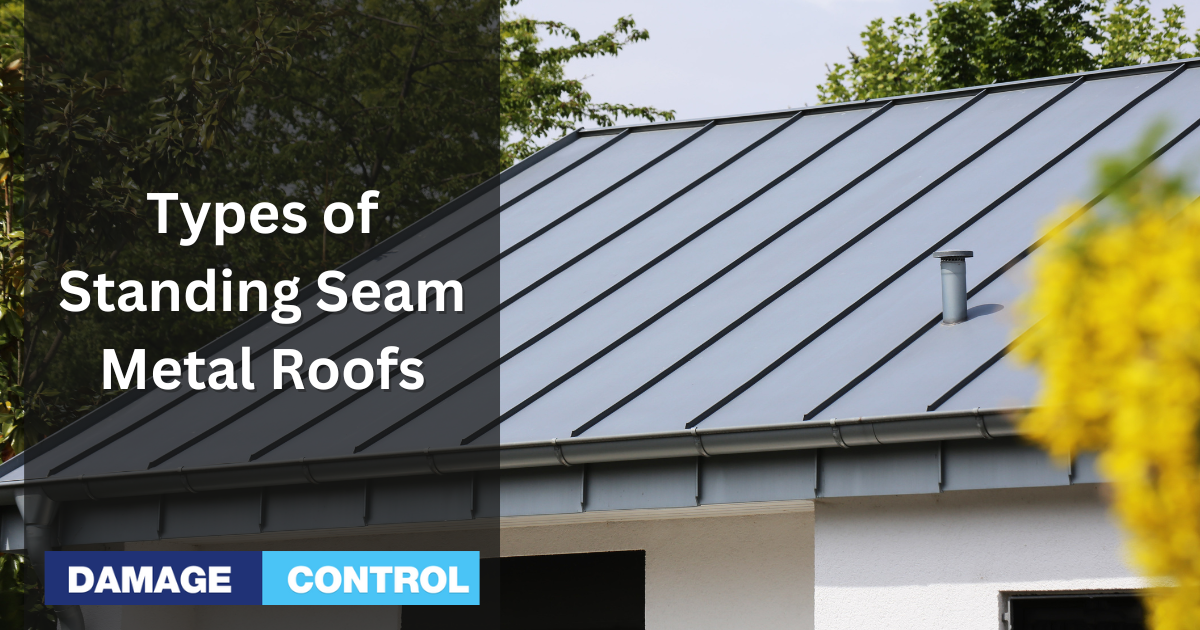Standing seam metal roofs have gained popularity over the years for their durability, aesthetics, and energy efficiency. Available in a variety of materials, these roofs are designed with continuous panels that run from the ridge of the roof down to the eaves. The seams between these panels are raised, hence the name “standing seam,” creating a weather-tight barrier that prevents water and air infiltration.
There are several types of standing seam metal roofs, each categorized by the engagement method of the panels and the materials used for construction. The primary materials used include aluminum, aluminum/zinc coated alloy, coated steel, and copper. These panels' three main engagement methods are snap-locked, mechanically seamed, and batten-locked. Each type offers unique benefits and installation procedures to suit various architectural designs and budget constraints.
Choosing the right standing seam metal roof type is essential for durability and longevity. As a contractor, guiding homeowners and building owners to an appropriate selection ensures optimal performance, minimal maintenance, and increased property value. In the following sections, we will delve deeper into each type of standing seam metal roof, providing insightful tips and considerations to aid in decision-making. Stay tuned for an engaging, educational, and entertaining adventure into the world of standing seam metal roofs.
Understanding the Basics of Standing Seam Metal Roofs
Let's kick things off by understanding the basics of these bad boys. What are they? Why are they so darn popular?
What are Standing Seam Metal Roofs and their Common Features?
So, you've got your regular roofs, and then you've got standing seam metal roofs. These are the superheroes of the roofing world. These bad boys are constructed with continuous panels running straight from the top, all the way down to the eaves. The seams? They're raised high, hence the catchy name “standing seam.” So, water, wind, or any element out there has a tough time infiltrating this fortress.
The materials? You've got some choices. Aluminum, aluminum/zinc coated alloy, coated steel, and even copper. And the panels? They're assembled in a few ways – snap-locked, mechanically seamed, or batten-locked. Neat, huh?
Why are Standing Seam Metal Roofs So Popular?
Now, you might be thinking, “Why should I jump on this standing seam metal roof bandwagon?” Here's why: They're durable, beautiful, and energy-efficient. You've got a roof that can withstand the harshest conditions, look pretty, and save you some green on your energy bill. Talk about a win-win-win!
Not to mention, the variety of materials means they can match the aesthetics of pretty much any building out there. Plus, their installation methods can be tailored to suit your budget. So, whatever your architectural style or wallet size, a standing seam metal roof has your name on it.
Okay, now that we've covered the basics, you're ready to dive into the different types of standing seam metal roofs. Are you pumped? You should be. It's time to take your roofing knowledge to the next level.
The Versatile Snap-Lock Standing Seam Systems
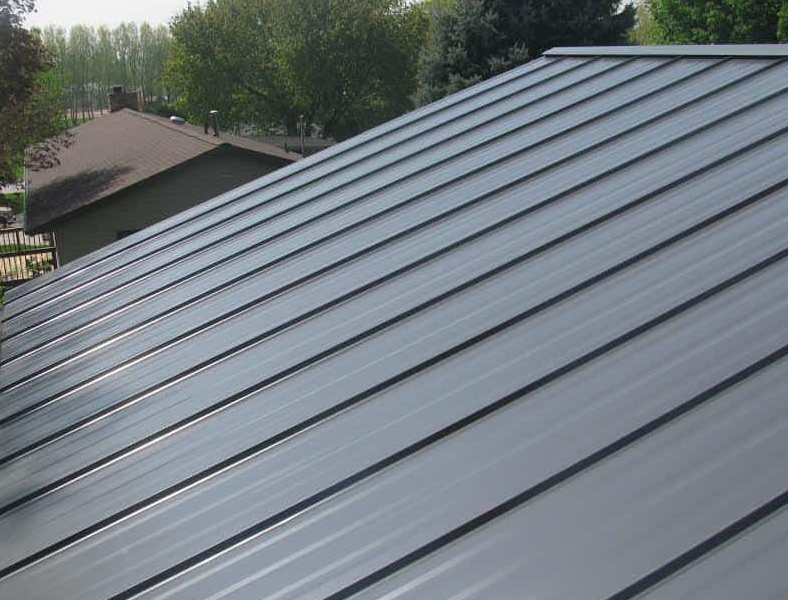
Now, let's talk about the first player in the game: the Snap-Lock standing seam system. This fella's got a lot going for it.
What are Snap-Lock Systems?
First, an informal introduction. Imagine roof panels that click together like puzzle pieces. That's what snap-lock systems are all about. They're designed in such a way that one panel literally snaps into the next. It's a quick, simple process that doesn't need any special seaming tools. Now, how cool is that?
What Makes Snap-Lock Systems Stand Out?
Onto the goodies, the features, and benefits. Snap-lock systems are fast to install, thanks to that oh-so-simple snap mechanism. They're efficient, they're cost-effective, and they're low maintenance. But that's not all. These roofs are also super durable, with high resistance to wind and weather. And let's not forget the aesthetics. With a snap-lock system, you get sleek lines and a modern look that's hard to beat.
Where do Snap-Lock Systems Shine?
And now, the cherry on top, the real-world applications. These snap-lock systems are versatile. They're great for both residential and commercial buildings. From the humble home to the high-rise office, from the trendy restaurant to the traditional church, the snap-lock system fits right in. They can handle roofs with a pitch of 3:12 or greater, making them a go-to choice for a wide variety of building types.
So there you have it. The snap-lock standing seam system in all its glory. A roofing solution that's as flexible as it is robust. Next up, we'll explore the next contender in the ring, the mechanically seamed system. Buckle up, and stay tuned!
Unraveling the Robust Mechanical Lock Standing Seam Systems
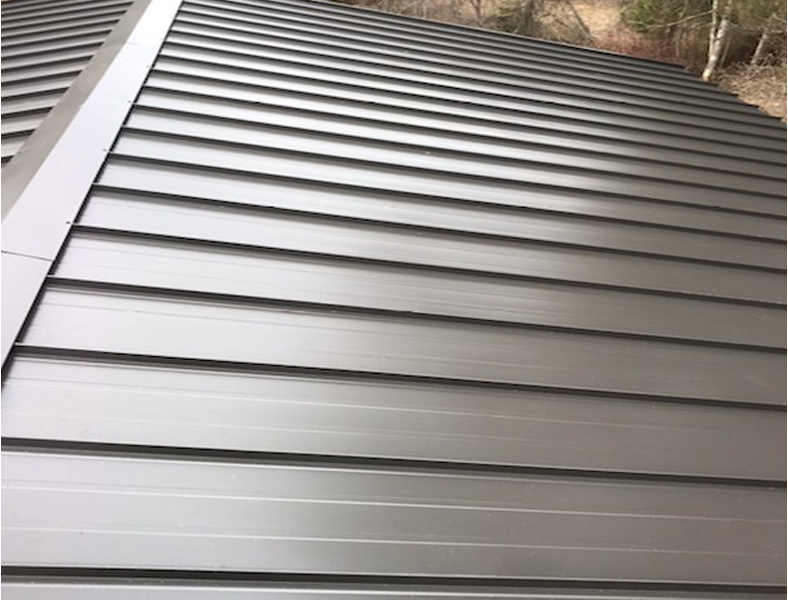
Onward to the next player on the field – the Mechanical Lock standing seam system. This champ's got a few tricks up its sleeve.
What are Mechanical Lock Systems?
Here's the lowdown. Mechanical lock systems don't just snap together. Oh no, they're a little more intricate. They require a special tool to crimp or “lock” the seams together. A bit more work, yes, but boy does it pay off!
What's Special about Mechanical Lock Systems?
Let's talk features and benefits. For starters, mechanical lock systems are incredibly secure. When you crimp those panels together, you create a super-strong, watertight seal. We're talking armor-plated levels of protection here.
And durability? You bet. These systems are hardy, resistant to all kinds of weather. And just like their snap-lock cousins, they offer that sleek, modern aesthetic that can jazz up any building.
Where do Mechanical Lock Systems Excel?
Now, where do these systems really shine? Well, they're perfect for low-sloped roofs. That's right. Where other systems might struggle, the mechanical lock system breezes through. Homes, commercial buildings, you name it. If it's got a low-sloped roof, the mechanical lock system is your best bet.
Alright, we've covered two of the biggies: the snap-lock and the mechanical lock system. Up next, we're going to delve into the final type of standing seam metal roof – the batten-lock system. So, don't go anywhere! We're just getting to the best part.
Decoding the Convenient Nail Flange Standing Seam Systems
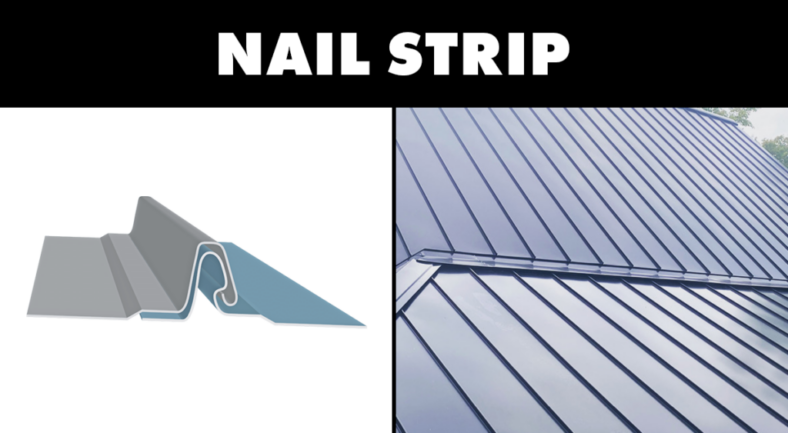
Alright, folks. Last but certainly not least, let's dive into the Nail Flange standing seam systems. You'll want to pay close attention to this one.
What are Nail Flange Systems?
In layman's terms, nail flange systems are about as straightforward as it gets. This system comes with pre-drilled holes right in the flange, so you can nail or screw the panels directly to the roof deck. Quick, easy, and practical – that's your nail flange system.
What Sets Nail Flange Systems Apart?
Now, let's dig a little deeper into those features and perks. First up, installation is a breeze. With those pre-drilled holes, you'll have your roof up and ready quickly. And let's not forget about cost-effectiveness. Fewer parts and less labor means more money stays in your pocket.
In terms of aesthetics, nail flange systems deliver, just like their snap-lock and mechanical lock counterparts. Sleek, modern, and eye-catching – that's what you get with a nail flange system.
Where do Nail Flange Systems Fit Best?
So, where does this system really shine? Nail flange systems are ideal for residential applications, particularly single-family homes. Why? They're designed for roofs with a pitch of 3:12 or greater. And with their easy installation and cost-effectiveness, they're a top pick for homeowners on a budget.
And there you have it – the rundown on nail flange standing seam systems. Three different systems, each with their own unique features and benefits. But remember, the best choice will always depend on your specific needs and circumstances. So, take the time to weigh your options and make an informed decision.
VI. Understanding the Role of Fastening Mechanisms in Standing Seam Roofs
A. Concept of fastening systems and their significance
B. Different types of fasteners and their roles
Metal Materials Used in Standing Seam Metal Roofs
Now that we've got the types of standing seam systems under our belts, let's shift gears to the materials used in these babies. Aluminum, copper, zinc, and steel – each one's got its own set of pros and cons.
Aluminum
First up, aluminum. This guy's lightweight, rust-resistant, and super versatile. But what makes aluminum really shine is its durability and its eco-friendliness. Did you know that most aluminum roofs are made from recycled material? Plus, they can be recycled again when they've served their time. How's that for sustainability?
Copper
Next, we have copper. This material is like the fine wine of roofing – it just gets better with age. Copper roofs develop a green patina over time, adding a unique aesthetic appeal. Plus, they're incredibly long-lasting. The downside? Copper's pricier than some other materials, but many would argue it's worth every penny.
Zinc
Then there's zinc. Like copper, zinc roofs age gracefully, developing a patina that protects against weathering and corrosion. Zinc's also a sustainable choice, given its long lifespan and recyclability. However, it can be more expensive than some other options.
Steel
Last but not least, steel. It's tough, it's durable, and it's got a pretty attractive price point. Many steel roofs are coated with aluminum, zinc, or a combination of both to boost their weather resistance.
Comparing the Materials
Okay, so which one's the best? Well, that's like asking someone to pick their favorite kid. It really depends on what you're after. If you want durability and sustainability, aluminum might be your top pick. For longevity and a touch of class, consider copper or zinc. And if you're after toughness on a budget, steel might be your best bet.
Remember, each material will bring something different to the table. So think about your needs, your budget, and your aesthetic preferences. And of course, don't hesitate to reach out to a professional for guidance. After all, choosing a roof is a big decision, and it's one you'll want to get right.
Installation Process of Standing Seam Metal Roofs
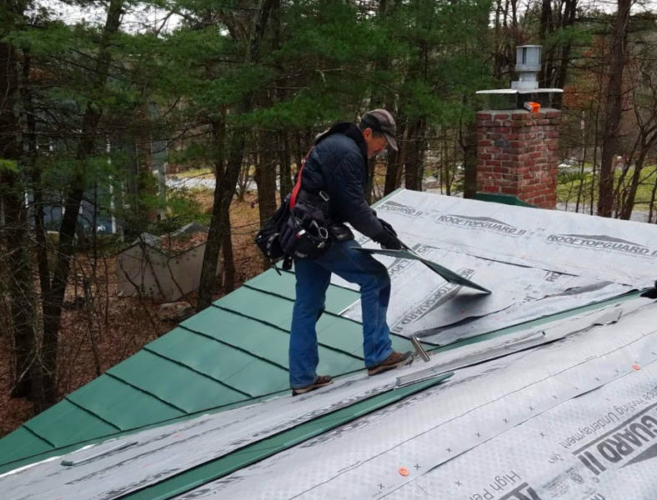
Alright, onto the next topic – installation. Ever wondered how these metal roofs get installed? Let's break it down.
What's the Installation Process Like?
First, a brief overview. Standing seam metal roofs are installed panel by panel. The panels are typically cut to length, formed, and then installed onto the roof deck. Each panel connects to the next, forming a seamless, weather-tight barrier.
The specifics can vary based on the system. Snap-lock systems, for example, can be snapped together by hand, while mechanical lock and nail flange systems require special tools.
It's not just about slapping panels onto a roof, though. There's also underlayment to consider, not to mention flashing, ventilation, and insulation. It's a complex process, requiring a keen eye and a steady hand.
Why is Professional Installation Crucial?
This brings us to the next point: professional installation. While DIY might be tempting, standing seam metal roofs are best left to the pros. A poorly installed roof can lead to leaks, damage, and a whole lot of headaches.
Professionals have the knowledge, skills, and tools to do the job right. They can ensure a proper fit, secure seams, and adequate ventilation. Plus, they can handle any challenges that might crop up during the installation.
So, there you have it – the basics of standing seam metal roof installation. It's not a simple process, but with the right team, you'll have a roof that's built to last. Stay tuned for our final section, where we'll wrap up all this juicy information into one neat package. You won't want to miss it!
Maintenance and Durability of Standing Seam Metal Roofs
Let's touch on the last puzzle piece – maintenance and durability. How long do these roofs last, and what kind of care do they need?
How Long do Standing Seam Metal Roofs Typically Last?
Starting with lifespan, here's the deal. Standing seam metal roofs are built to last. Depending on the material and maintenance, they can last anywhere from 40 to 70 years. That's right, you heard it here first. That's a whole lot longer than your typical asphalt shingle roof.
The material plays a big part in this. Copper and zinc, for example, can last upwards of 100 years. Aluminum and steel, while not quite as long-lasting, still hold their own, with lifespans reaching up to 60 years.
What are Some Maintenance Tips and Guidelines?
So, how do you keep your roof in tip-top shape? The good news is, maintenance for standing seam metal roofs is relatively low-key. Regular inspections, at least twice a year, are a good place to start. Look out for any signs of damage or wear and tear, and address any issues promptly.
Cleaning is another important aspect. Remove any debris that might have accumulated on the roof, like leaves or branches. This helps prevent moisture buildup and keeps those panels looking their best.
Lastly, always hire a professional for any repairs or major maintenance tasks. Remember, a well-maintained roof is a long-lasting roof.
Conclusion
Let's quickly recap what we've uncovered as we wrap up our deep dive into standing seam metal roofs. We've explored the basics of standing seam metal roofs, their common features, and the key benefits they bring. We've dissected three types of standing seam systems – snap-lock, mechanical lock, and nail flange – and dove into their unique features and ideal applications.
We've also examined the different metal materials used in these roofs, and we've outlined some factors to consider when choosing a roof, such as the type of structure, climatic conditions, budget, and aesthetics. Plus, we've given a sneak peek into the installation process and highlighted the importance of professional installation. Lastly, we've discussed the typical lifespan of these roofs and shared some handy maintenance tips.
So, where does all this information leave you? I hope, armed with a wealth of knowledge and a clearer understanding of what standing seam metal roofs can offer. Whether you're a homeowner looking for a durable and stylish roofing option, or a building owner seeking a long-lasting and energy-efficient solution, standing seam metal roofs are worth considering.
Remember, the best choice will always depend on your unique circumstances. And when in doubt, don't hesitate to seek professional advice. Choosing a roof is a significant investment that can boost your property value, enhance your building's appearance, and provide peace of mind for many years to come. So take the time to make an informed decision, and may your roofing journey be as smooth and seamless as the roofs we've discussed today!
Frequently Asked Questions
To close out our comprehensive guide, let's address some common questions you might still have about standing seam metal roofs.
What is the Average Lifespan of a Standing Seam Metal Roof?
Standing seam metal roofs are built tough. Depending on the material and maintenance, they can last anywhere from 40 to 70 years, and sometimes even more! Copper and zinc, in particular, can last upwards of 100 years. Now, that's longevity for you!
What are the Main Differences between Snap-Lock, Mechanical Lock, and Nail Flange Systems?
Good question! Snap-Lock systems are quick to install and work best on steep roofs. Mechanical Lock systems, on the other hand, are suitable for both steep and low-slope roofs but require special tools for installation. Nail Flange systems are also quick to install, but they're mostly suitable for residential structures with steep roofs.
What Type of Standing Seam Metal Roof is Best for Harsh Climates?
If you're dealing with harsh weather, like heavy snowfall, wind, or even saltwater exposure, you'll want a durable, weather-resistant material. Aluminum and coated steel can be particularly effective in such conditions.
Can I Install a Standing Seam Metal Roof Myself?
While DIY might be tempting, standing seam metal roofs are best left to the pros. Installation is a complex process that requires specialized tools and knowledge. Plus, a poorly installed roof can lead to leaks and damage. So, save yourself the headache and go with a professional.
How does the Cost of a Standing Seam Metal Roof Compare to Traditional Roofing Options?
Standing seam metal roofs can be more expensive upfront than traditional asphalt shingle roofs. However, they also last much longer and require less maintenance, saving you money in the long run.
And there you have it – answers to some of your burning questions about standing seam metal roofs. I hope this guide has been helpful, and don't hesitate to reach out if you have any more queries. After all, we're all about making your roofing journey as smooth and seamless as possible.
Additional Resources
Alright, that was quite a journey through standing seam metal roofing! But hey, why stop there? We have a whole lot more roofing knowledge to share. Ready to dive in deeper? Let's go.
While metal roofing is incredible, other options might tickle your fancy. For example, if you have a mobile home, you might be interested in our piece on mobile home roofing. It's a great read offering practical advice on keeping your mobile home's roof in tip-top shape. And who knows, you might find it's the perfect solution for your particular needs.
On the other hand, maybe you're interested in exploring a more premium material for your roof. If that's the case, you can't miss out on our comprehensive Copper Roofing: The Ultimate Guide for Homeowners. This guide walks you through everything you need to know about copper roofing, a material known for its timeless beauty and unparalleled longevity.
But hey, let's not forget about this. Roofing is just one part of your home's overall well-being. We offer Orlando's Trusted Water Damage Restoration Services to help you bounce back from any unexpected incidents. From floods to plumbing disasters, we've got you covered.
And if you're ever worried about pesky mold creeping into your home, our Expert Mold Testing and Remediation in Orlando service is precisely what you need. We're here to ensure your home remains a safe and healthy space for you and your family. Because at the end of the day, your peace of mind is what matters most to us.
So go on, explore these resources, and let us know if there's anything else we can help you with. Your roofing and home care journey is just beginning, and we're excited to be a part of it.

